Abstract
In the past, comprehensive information was imperative for image processing, prompting a preference for high-depth cameras. However, in our research, we discovered that the abundance of image details may impede phase retrieval. Consequently, this paper presents an iterative phase retrieval method based on a low bit depth. Through simulations and experiments, this approach has proven effective in evidently enhancing phase retrieval outcomes. Furthermore, the concept of low bit depth holds promise for broader application across diverse domains within the field of image retrieval.
1. Introduction
In the era of big data, the amount of data has exploded, necessitating the urgent development of high-capacity data storage devices [1,2,3]. Holographic data storage (HDS), introduced by Van Heerden in 1963, offers a promising solution [4]. HDS is characterized by its substantial storage capacity, extended archival lifespan, and rapid data access. Various multiplexing techniques, including shift multiplexing [5,6], wavelength multiplexing [7], angle multiplexing [8,9], orbital angular momentum multiplexing [10,11], and polarization multiplexing [12,13], among others [14,15], are employed in holographic storage. The concurrent application of multiple multiplexing techniques further enhances storage capacity. As a result, HDS and related technologies have garnered considerable attention [16,17,18,19,20,21,22,23,24,25].
Amplitude modulation and phase modulation stand as the two primary methodologies for holographic data storage. In amplitude-modulated HDS, pixels exhibit only two states, bright and dark, resulting in a relatively low coding rate [26,27]. Phase-modulated HDS, on the other hand, achieves a higher coding rate and enhances storage density. However, direct detection of phase information by the detector is unfeasible. Typically, phase retrieval is accomplished through interferometric and non-interferometric methods. Interferometry entails introducing another beam to interfere with the measured beam to extract the phase. However, this approach demands high system stability and is often avoided [28,29]. Non-interferometric methods offer simplicity and stability. Numerous non-interferometric phase retrieval algorithms exist, including the psychographic iterative engine (PIE) algorithm, the transport of intensity equation (TIE), and the iterative Fourier transform (IFT) algorithm [30,31,32,33,34,35]. This paper adopts the IFT algorithm, capable of phase retrieval in a single shot with system stability.
Typically, the IFT algorithm necessitates extensive iterative computations. To mitigate the number of iterations, we integrate embedded data into the data page to augment the known data within the spectrum. The detector represents the captured beam intensity as discrete grayscale values, reflecting the bit depth of the detector. Moreover, images captured by high-bit-depth cameras tend to offer more realistic information. Traditionally, it was believed that high-bit-depth images could enhance the phase retrieval process. However, our findings suggest that low-bit-depth images yield superior results for phase retrieval, presenting a counterintuitive conclusion.
2. Theory and Methods
Figure 1 shows the scheme of a non-interference phase retrieval system. During the recording process, a spatial light modulator (SLM) is employed to upload phase information into the signal beam. The hologram is generated through the interference of the reference and signal beams within the recording medium. Subsequently, in the reading process, the hologram is illuminated with the same reference beam on the medium to produce a reconstructed beam, identical to the signal beam. As the reconstructed beam traverses the Fourier lens, the detector records the intensity distribution of the spectrum. The phase of the signal beam can be extracted from the spectrum intensity distribution using the inverse IFT algorithm. Traditionally, the spectrum is directly utilized for phase retrieval, disregarding the consideration of the bit depth. The bit depth represents the extent of the grayscale depth in an image, serving as a metric for expressing the capability of grayscale variations. A greater bit depth signifies a higher precision in color representation, though it also demands a larger storage space. The selection of an appropriate bit depth necessitates careful consideration of the intended purpose and specific context of the image.

Figure 1.
Diagram of the phase-modulated holographic storage system, where Sig. is the signal beam, Ref. is the reference beam, and Rec. is the reconstructed beam.
The low-bit-depth intensity distribution combined with the IFT algorithm is outlined as follows. Initially, we hypothesize that the initial phase of the reconstructed beam is φn, n = 1,2,3,…, with the subscript varying according to the number of iterations. As the information is phase-only encoded, we assume the amplitude to be 1. The expression for the complex amplitude distribution can be formulated as shown in Equation (1).
Then, the Fourier transform is performed on the complex amplitude distribution to simulate the effect of the Fourier lens in the optical system. The resulting complex amplitude distribution in the Fourier domain is depicted in Equation (2).
where F{} represents the Fourier transform.
The Fourier intensity distribution captured by a CMOS detector is normalized, as illustrated in Equation (3).
where round{} denotes round off, k represents the value of the bit depth, I is the spectrum intensity distribution captured by a CMOS detector, and σmax signifies the maximum values of the intensity distribution.
We replace the amplitude in the result of Equation (2) with the square root of the processed intensity distribution, denoted as A = (I*)1/2. The resulting expression is depicted in Equation (4).
Following the inverse Fourier transform, a revised estimation of the complex amplitude of the reconstructed beam is derived. Subsequently, by setting An+1 to 1 and employing the embedded data to rectify the phase, the updated distribution is illustrated in Equation (5).
where φn+1 represents a new estimate of the phase pattern of the signal beam, and F−1{} denotes the inverse Fourier transform.
We continue iterating through the aforementioned steps until the phase pattern of the signal beam converges.
Given the inherent challenge of discerning subtle distinctions between different bit depths with the human eye, we enhance the intensity distribution using color to amplify the discernible impact of the bit depth on the sampling outcomes, as demonstrated in Figure 2a–d. Upon magnified inspection of a specific region within an image, it becomes conspicuous that the 5-bit intensity distribution exhibits distinct stratification and a lack of smoothness in its intensity transitions, thereby resulting in the loss of certain information. In contrast, the intensity distribution achieved with a higher bit depth demonstrates a more seamless and natural progression of intensity levels, effectively preserving a greater amount of information. The figure highlights that images with a higher bit depth exhibit smoother details, whereas those with a lower bit depth may lose some intricacies. The spectral intensity distribution, being the sole known input of the IFT algorithm, holds significant weight in influencing the ultimate outcome of phase retrieval, particularly in regard to variations in image complexity.
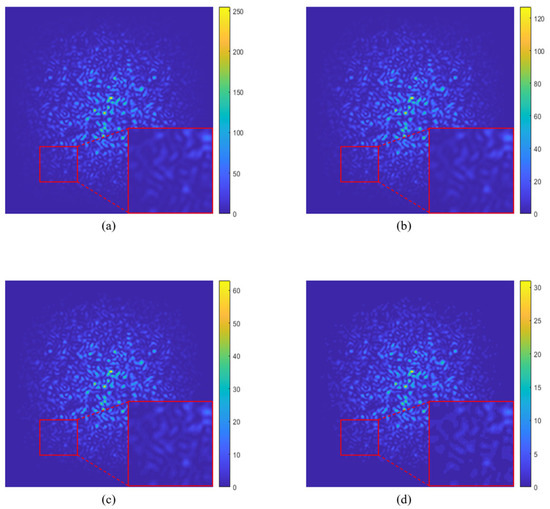
Figure 2.
The impact of the bit depth on the intensity distribution. (a–d) The intensity distribution with the color corresponding to different bit depths (8 bit, 7 bit, 6 bit, and 5 bit).
3. Simulation and Experiment
In this paper, we initially simulated the effects of various bit depths on phase retrieval. To ensure the validity of the simulated results, we maintained uniformity between the simulation parameters and those utilized in the experiments.
First of all, without considering the influence of noise, we utilized a random 4-level phase pattern (0, π/2, π, 3π/2) as the data page, comprising 32 × 32 phase data. Each of the phase data were displayed in a small area of 4 × 4 pixels on the SLM. The intensity distribution in the Fourier domain was obtained through a numerical simulation. Subsequently, the phase retrieval was processed utilizing spectral intensity distributions at various bit depths, followed by the calculation of the corresponding phase error rates (PERs). The calculation method of the PER is shown in Equation (5). Nerror indicates the number of errors in a data page, and Ndata indicates the total amount of data in a data page.
The curve of the relationship between the bit depth and iteration number is shown in Figure 3. The ordinate represented the number of iterations required for the PER to drop to 0. In this part, we employed the iteration number to evaluate the effect of the phase retrieval, where a higher iteration number signifies a longer duration for phase retrieval. The results demonstrated that the phase retrieval speed is faster at low bit depths compared to high bit depths.
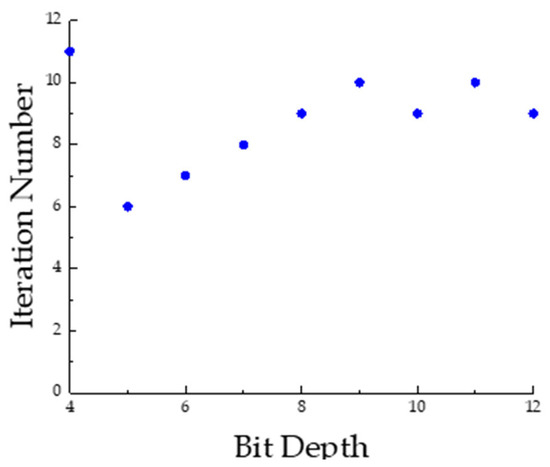
Figure 3.
Iteration speed under different camera bit depths.
In a real HDS system, noise is inevitable. Therefore, we considered the case of noise by adding Gaussian noise of varying degrees to the intensity distribution, resulting in different signal-to-noise ratios (SNR = 18, 14, 10, and 6). This allowed us to demonstrate the effectiveness of the low-bit-depth method. In this part, we utilized the PER to evaluate the phase retrieval effect, where a lower PER indicates a higher quality of the phase retrieval result. Figure 4 shows the curve of the bit depth and PER in the same iteration number. It was evident that regardless of the noise level, the phase retrieval effect of the spectrum with a low bit depth consistently surpassed that of the spectrum with a high bit depth. Particularly, in instances of a low bit depth, the PER can reach a value of 0, indicating the perfect retrieval of phase information.
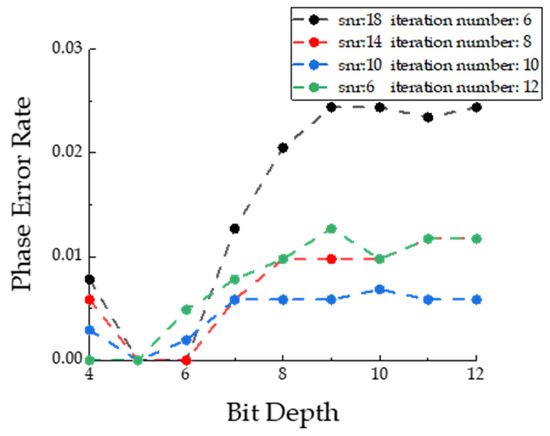
Figure 4.
The curve of the bit depth and PER in the same iteration number.
We conducted experiments using the holographic data storage system depicted in Figure 5. In this optical setup, the laser first passes through a beam expander to create a large spot and then filters the spot through a square aperture into a square shape to ensure that it is the same size as the phase data page. The square light spot illuminates the data page pattern in the SLM after the 4f system, and the phase information carried by the reflected light is gathered by Lens3 and recorded on the material. The function of the 4f system is to propagate the beam to another location intact. After Lens5, the phase data page is converted from the Fourier domain to the spatial domain. The function of Lens6 is to perform the Fourier transform, and the Fourier intensity distribution of the data page is finally obtained by the CMOS. The laser wavelength was 532 nm with a power of 300 mW. The SLM utilized was the X10468-04 model manufactured by HAMAMATSU (Hamamatsu, Japan), featuring a resolution of 792 × 600 and a pixel size of 20 μm. The camera employed was the DCC3260M model from Thorlabs (Newton, NJ, USA), with a resolution of 1936 × 1216 and a pixel size of 5.86 μm. The focal length of the Fourier lens was 300 mm. The encoded phase page included fifty percent of the embedded data.
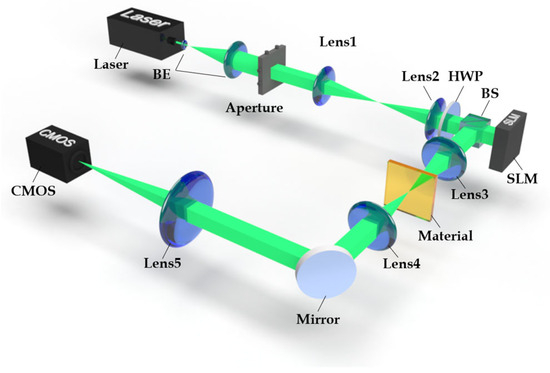
Figure 5.
The optical setup of the holographic data storage system, where BE is the beam expander, HWP is the half-wave plate, BS is the beam splitter, SLM is the spatial light modulator, and CMOS is the complementary metal oxide semiconductor.
The data page used in the experiment contained 32 × 32 phase data with an oversampling of 4 × 4. Using more pixels to display the phase data evidently reduced the PER. Figure 6a illustrates the original phase data uploaded on the SLM, while Figure 6b depicts the simulated Fourier spectrum intensity distribution corresponding to Figure 6a. The actual spectrum intensity distribution obtained from the experiment is presented in Figure 6c. In comparison with the simulation result in Figure 6b, the bright spot in the center represented the noise generated by the system. Through the simulation, we ascertained that low-bit-depth spectra can enhance the effect of phase retrieval, as demonstrated in Figure 3 and Figure 4. Figure 7 shows the phase retrieval effect of different bit-depth spectrums in the experiment. As the spectrum with a low bit depth cannot be directly captured by the camera, we employed the method described in the second section to achieve low-bit-depth detection. Notably, when the spectrum bit depth was 6, the PER reached its lowest point. The detailed phase retrieval results for different bit-depth spectra are depicted in Figure 8, where the white dots in the error distribution denoted incorrect phase data in the reconstructed phase.

Figure 6.
(a) Original phase data. (b) Simulated Fourier spectrum intensity distribution. (c) Spectrum intensity distribution obtained by experimental shooting.
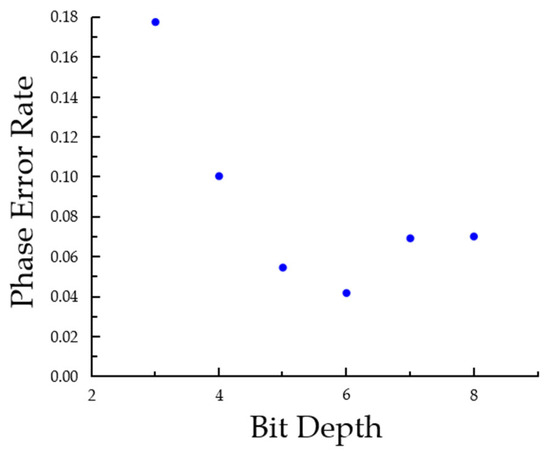
Figure 7.
The curve of the bit depth and PER by the experiment.
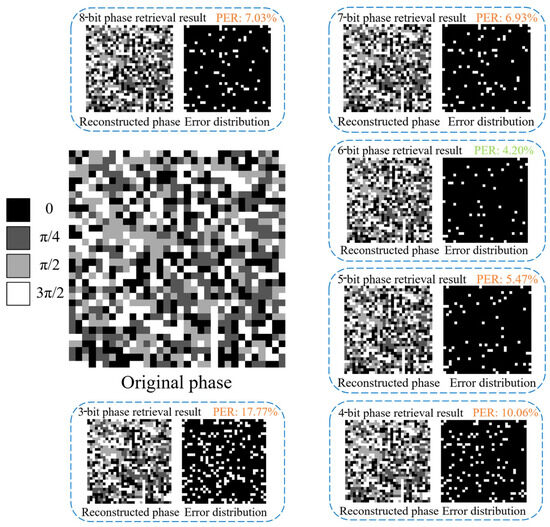
Figure 8.
Detailed phase retrieval results for different bit-depth spectrums.
The experimental findings indicated that when the bit depth is 6 bits, the PER was minimized after 10 iterations. These experimental results aligned closely with the simulation outcomes. It was evident that the Fourier spectrum with a low bit depth was more conducive to phase retrieval compared to that with a high bit depth.
In the preceding experiment, we employed a fourth-order phase as the data structure, with a data size of 32 × 32 and an oversampling factor of 4. To assess the efficacy of the low-bit-depth sampling method with alternative data structures, subsequent experiments involved modifications to the phase level and the amount of data on the data page, each accompanied by distinct oversampling settings on the SLM. The experimental results are summarized in Table 1. Based on these findings, the PER initially decreased and then increased as the bit depth decreased. As evident from the table, in the majority of instances, a 6-bit bit depth achieves the lowest PER.

Table 1.
Explore the generalization of the low-bit phase retrieval method.
The experimental results robustly demonstrated the effectiveness of our approach across various data structures. Specifically, when the number of iterations was kept constant, the PER for 6-bit representations consistently outperformed that for the 8-bit counterparts. This substantiated the impact of the spectrum complexity on the phase retrieval outcomes. Upon scrutinizing the dynamic trend of the optimal bit depth, it became evident that more intricate data structures generally demanded a higher-spectrum bit depth. However, such complexity did not necessarily require the use of an 8-bit intensity distribution. As the only known input to the IFT algorithm, the spectrum bit depth plays a crucial role in both the algorithm’s efficiency and the accuracy of phase retrieval. The imprudent use of overly intricate spectra during phase retrieval may impede the algorithm’s retrieval speed. Hence, the prudent application of low-bit-depth images as input proved crucial in enhancing the efficiency of the IFT.
4. Discussion
The simulation and experimental results show that compared with the input of the normal bit depth, the Fourier intensity distribution of a low depth can effectively improve the phase retrieval efficiency of the IFT algorithm. Because of the simplicity of the phase data page, it does not need a too complex intensity distribution to realize the need for phase retrieval. An overly complex intensity distribution for retrieving phase data pages can lead to reduced efficiency.
Because it is very difficult to obtain low-depth cameras, the bit-depth conversion method proposed in this paper is used in experiments. The intensity distribution of the normal bit depth obtained by the CMOS is converted to a low-depth intensity distribution, and a lower phase retrieval error rate is obtained. The method involves simple operation and has low computational overhead. Moreover, the low-depth method has the advantage of good compatibility and can be combined with other methods to improve the performance of HDS. This advantage provides support for phase data storage, leading to the development of HDS.
5. Conclusions
In this study, we observed that the efficiency of phase retrieval is inversely proportional to the image bit depth. We incorporated the low-bit-depth spectrum distribution as a constraint in the iterative process of the IFT algorithm. Simulations and experiments verified that the phase retrieval speed of this method surpasses that of the traditional 8-bit spectrum. The utilization of a low bit depth simplified the spectral distribution and diminished the computational overhead, thus enabling faster phase retrieval.
Author Contributions
Conceptualization, X.L. (Xiao Lin) and X.T.; Data curation, H.L. and S.Z.; Formal analysis, Y.L., H.S., X.X., X.L. (Xiong Li), J.Z. and Q.C.; Methodology, H.L. and X.L. (Xiao Lin); Project administration, X.L. (Xiao Lin) and X.T.; Software, H.L. and X.L. (Xiao Lin); Validation, H.L. and S.Z.; Writing—original draft, H.L. and S.Z.; Writing—review and editing, X.L. (Xiong Li), J.Z., Q.C., X.L. (Xiao Lin) and X.T. All authors have read and agreed to the published version of the manuscript.
Funding
This research was funded by the Natural Science Foundation of Fujian Province, grant number 2021J01160; National Natural Science Foundation of China (NSFC), grant number U22A2080; National Key Research and Development Program of China, grant number 2018YFA0701800; and Project of Fujian province major science and technology, grant number 2020HZ01012.
Institutional Review Board Statement
Not applicable.
Informed Consent Statement
Not applicable.
Data Availability Statement
The data underlying the results presented in this paper are not publicly available at this time but may be obtained from the authors upon reasonable request.
Conflicts of Interest
The authors declare no conflicts of interest.
References
- Reinsel, D.; Gantz, J.; Rydning, J. The Digitization of the World from Edge to Core. Available online: https://www.seagate.com/files/www-content/our-story/trends/files/idc-seagate-dataage-whitepaper.pdf (accessed on 16 July 2024).
- Sony, Panasonic. White Paper: Archival Disc Technology. Available online: https://panasonic.cn/wp-content/uploads/2020/05/Archival-Disc-Technology-%EF%BC%9A2nd-Edition.pdf (accessed on 16 July 2024).
- Lin, X.; Hao, J.; Zheng, M.; Dai, T.; Li, H.; Ren, Y. Optical holographic data storage-The time for new development. Opto-Electron. Eng. 2019, 46, 180642. [Google Scholar]
- Van Heerden, P.J. Theory of optical information storage in solids. Appl. Opt. 1963, 2, 393–400. [Google Scholar] [CrossRef]
- Pasltis, D.; Levene, M.; Pu, A.; Barbastathis, G.; Curtis, K. Holographic digital data storage using shift multiplexing. Opt. Lett. 1995, 20, 782. [Google Scholar] [CrossRef] [PubMed]
- Takabayashi, M.; Okamoto, A.; Eto, T.; Okamoto, T. Shift-multiplexed self-referential holographic data storage. Appl. Opt. 2014, 53, 4375–4381. [Google Scholar] [CrossRef] [PubMed]
- Rakuljic, G.; Leyva, V.; Yariv, A. Optical data storage by using orthogonal wavelength-multiplexed volume holograms. Opt. Lett. 1992, 17, 1471–1473. [Google Scholar] [CrossRef] [PubMed]
- Mok, F. Angle-multiplexed storage of 5000 holograms in lithium niobite. Opt. Lett. 1993, 18, 915–917. [Google Scholar] [CrossRef] [PubMed]
- Cao, L.; Wang, Z.; Zhang, H.; Jin, G.; Gu, C. Volume holographic printing using unconventional angular multiplexing for three-dimensional display. Appl. Opt. 2016, 55, 6046. [Google Scholar] [CrossRef] [PubMed]
- Ouyang, X.; Xu, Y.; Xian, M.; Feng, Z.; Zhu, L.; Cao, Y.; Lan, S.; Guan, B.; Qiu, C.; Gu, M.; et al. Synthetic helical dichroism for six-dimensional optical orbital angular momentum multiplexing. Nat. Photonics 2021, 15, 901–907. [Google Scholar] [CrossRef]
- Fang, X.; Ren, H.; Gu, M. Orbital angular momentum holography for high-security encryption. Nat. Photonics 2020, 14, 102–108. [Google Scholar] [CrossRef]
- Wang, Q.; Eric, P.; Yang, Q.; Zhang, X.; Quan, X.; Xu, Y.; Han, J.; Zhang, W. Reflective chiral meta-holography: Multiplexing holograms for circularly polarized waves. Light Sci. Appl. 2018, 7, 25. [Google Scholar] [CrossRef]
- Guo, J.; Wang, T.; Quan, B.; Zhao, H.; Gu, C.; Li, J.; Wang, X.; Situ, G.; Zhang, Y. Polarization multiplexing for double images display. Opto-Electron. Adv. 2019, 2, 180029. [Google Scholar] [CrossRef]
- Khonina, S.; Kazanskiy, N.; Butt, M.; Karpeev, S. Optical multiplexing techniques and their marriage for on-chip and optical fiber communication: A review. Opto-Electron. Adv. 2022, 5, 210127. [Google Scholar] [CrossRef]
- Tang, D.; Shao, Z.; Xie, X.; Zhou, Y.; Zhang, X.; Fan, F.; Wen, S. Flat multifunctional liquid crystal elements through multi-dimensional information multiplexing. Opto-Electron. Adv. 2023, 6, 220063. [Google Scholar] [CrossRef]
- Haw, M. Holographic data storage: The light fantastic. Nature 2003, 422, 556–558. [Google Scholar] [CrossRef] [PubMed]
- Yoneda, N.; Nobukawa, T.; Morimoto, T.; Saita, Y.; Nomura, T. Common-path angular-multiplexing holographic data storage based on computer-generated holography. Opt. Lett. 2021, 46, 2920–2923. [Google Scholar] [CrossRef] [PubMed]
- Lin, X.; Liu, J.; Hao, J.; Wang, K.; Zhang, Y.; Li, H.; Horimai, H.; Tan, X. Collinear holographic data storage technologies. Opto-Electron. Adv. 2020, 3, 19000401–19000408. [Google Scholar] [CrossRef]
- Nobukawa, T.; Nomura, T. Multilevel recording of complex amplitude data pages in a holographic data storage system using digital holography. Opt. Express 2016, 24, 21001–21011. [Google Scholar] [CrossRef] [PubMed]
- Nobukawa, T.; Nomura, T. Linear phase encoding for holographic data storage with a single phase-only spatial light modulator. Appl. Opt. 2016, 55, 2565–2573. [Google Scholar] [CrossRef]
- Yan, X.; Liu, X.; Li, J.; Zhang, Y.; Chang, H.; Jing, T.; Hu, H.; Qu, Q.; Wang, X.; Jiang, X. Generating multi-depth 3d holograms using a fully convolutional neural network. Adv. Sci. 2024, 2308886. [Google Scholar] [CrossRef]
- Hao, J.; Lin, X.; Lin, Y.; Chen, M.; Chen, R.; Situ, G.; Horimai, H.; Tan, X. Lensless complex amplitude demodulation based on deep learning in holographic data storage. Opto-Electron. Adv. 2023, 6, 220157. [Google Scholar] [CrossRef]
- Nguyen, T.A.; Lee, J. A Nonlinear Convolutional Neural Network-Based Equalizer for Holographic Data Storage Systems. Appl. Sci. 2023, 13, 13029. [Google Scholar] [CrossRef]
- Zhu, J.; Zou, F.; Wang, L.; Lu, X.; Zhao, S. Multiplexing Perfect Optical Vortex for Holographic Data Storage. Photonics 2023, 10, 720. [Google Scholar] [CrossRef]
- Wang, J.; Tan, X.; Qi, P.; Wu, C.; Huang, L.; Xu, X.; Huang, Z.; Zhu, L.; Zhang, Y.; Lin, X.; et al. Linear polarization holography. Opto-Electron. Sci. 2022, 1, 210009. [Google Scholar] [CrossRef]
- Neifeld, M.; Chou, W. Information theoretic limits to the capacity of volume holographic optical memory. Appl. Opt. 1997, 36, 514–517. [Google Scholar] [CrossRef] [PubMed]
- Takabayashi, M.; Okamoto, A.; Tomita, A.; Bunsen, M. Symbol Error Characteristics of Hybrid-Modulated Holographic Data Storage by Intensity and Multi Phase Modulation. Jpn. J. Appl. Phys. 2011, 50, 09ME05. [Google Scholar] [CrossRef]
- Li, Z.; Yan, M.; Zeng, T.; Zhang, G. Phase retrieval from incomplete data via weighted nuclear norm minimization. Pattern Recognit. 2022, 125, 108537. [Google Scholar] [CrossRef]
- Jeon, S.; Gil, S. 2-step Phase-shifting Digital Holographic Optical Encryption and Error Analysis. J. Opt. Soc. Korea 2011, 15, 244–251. [Google Scholar] [CrossRef][Green Version]
- Maiden, A.; Rodenburg, J. An improved psychographic phase retrieval algorithm for diffractive imaging. Ultramicroscopy 2009, 109, 1256–1262. [Google Scholar] [CrossRef]
- Pan, X.; Liu, C.; Lin, Q.; Zhu, J. Ptycholographic iterative engine with self-positioned scanning illumination. Opt. Express 2013, 21, 6162–6168. [Google Scholar] [CrossRef]
- Volkov, V.; Zhu, Y.; Graef, M. A new symmetrized solution for phase retrieval using the transport of intensity equation. Micron 2002, 33, 411–416. [Google Scholar] [CrossRef]
- Fienup, J. Phase retrieval algorithms: A comparison. Appl. Opt. 1982, 21, 2758–2769. [Google Scholar] [CrossRef] [PubMed]
- Huang, Z.; Memmolo, P.; Ferraro, P.; Cao, L. Dual-plane coupled phase retrieval for non-prior holographic imaging. PhotoniX 2022, 3, 3. [Google Scholar] [CrossRef]
- Shu, Y.; Sun, J.; Lyu, J.; Fan, Y.; Zhou, N.; Ye, R.; Zheng, G.; Chen, Q.; Zuo, C. Adaptive optical quantitative phase imaging based on annular illumination Fourier ptychographic microscopy. PhotoniX 2022, 3, 24. [Google Scholar] [CrossRef]
Disclaimer/Publisher’s Note: The statements, opinions and data contained in all publications are solely those of the individual author(s) and contributor(s) and not of MDPI and/or the editor(s). MDPI and/or the editor(s) disclaim responsibility for any injury to people or property resulting from any ideas, methods, instructions or products referred to in the content. |
© 2024 by the authors. Licensee MDPI, Basel, Switzerland. This article is an open access article distributed under the terms and conditions of the Creative Commons Attribution (CC BY) license (https://creativecommons.org/licenses/by/4.0/).